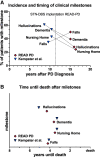Morbidity Milestones Demonstrate Long Disability-Free Survival in Parkinson's Disease Patients with Deep Brain Stimulation of the Subthalamic Nucleus
- PMID: 37070057
- PMCID: PMC10105113
- DOI: 10.1002/mdc3.13698
Morbidity Milestones Demonstrate Long Disability-Free Survival in Parkinson's Disease Patients with Deep Brain Stimulation of the Subthalamic Nucleus
Abstract
Background: Deep brain stimulation of the subthalamic nucleus (STN-DBS) is an effective treatment for Parkinson's disease (PD). The long-term benefit in PD patients with STN-DBS in comparison to medical treatment (MT) alone has not yet been demonstrated conclusively.
Objectives: To judge the long-term outcome of patients with STN-DBS.
Methods: To assess the evolution of PD symptoms and health-related quality of life (HRQoL) after deep brain stimulation (DBS) surgery, we conducted a cross-sectional analysis of 115 patients with STN-DBS with rater-based scales and self-reported questionnaires. In addition, we screened records of all our STN-DBS patients (2001-2019, n = 162 patients) for the onset of the morbidity milestones (falls, hallucinations, dementia, and nursing home placement) to assess disability-free life expectancy.
Results: In the first year of STN-DBS, levodopa equivalent dose was reduced and motor function improved. Nonmotor symptoms and cognition remained stable. These effects were similar to previous studies. Morbidity milestones occurred 13 ± 7 years after diagnosis. Motor function, cognition, and HRQoL significantly worsened after the occurrence of any milestone, confirming the clinical relevance of these milestones. After onset of the first milestone, mean survival time was limited to 5 ± 0.8 years, which is comparable with patients with PD but without STN-DBS.
Conclusions: On average, PD patients with STN-DBS live with their disease for a longer time, and morbidity milestones occur later in the disease course than in PD patients with MT. As judged by morbidity milestones, morbidity remains compressed into the final 5 years of life in PD patients with STN-DBS.
Keywords: Parkinson's disease; deep brain stimulation; long‐term outcome; milestones; morbidity..
© 2023 The Authors. Movement Disorders Clinical Practice published by Wiley Periodicals LLC on behalf of International Parkinson and Movement Disorder Society.
Figures





Similar articles
-
Long-term follow-up of subthalamic nucleus deep brain stimulation in patients with Parkinson's disease: An analysis of survival and disability milestones.Parkinsonism Relat Disord. 2024 Jan;118:105921. doi: 10.1016/j.parkreldis.2023.105921. Epub 2023 Nov 11. Parkinsonism Relat Disord. 2024. PMID: 37976978
-
Development of Clinical Milestones in Parkinson's Disease After Bilateral Subthalamic Deep Brain Stimulation.J Mov Disord. 2022 May;15(2):124-131. doi: 10.14802/jmd.21106. Epub 2022 May 26. J Mov Disord. 2022. PMID: 35670021 Free PMC article.
-
Key clinical milestones 15 years and onwards after DBS-STN surgery-A retrospective analysis of patients that underwent surgery between 1993 and 2001.Clin Neurol Neurosurg. 2017 Mar;154:43-48. doi: 10.1016/j.clineuro.2017.01.010. Epub 2017 Jan 18. Clin Neurol Neurosurg. 2017. PMID: 28113102
-
Nonmotor Symptoms and Subthalamic Deep Brain Stimulation in Parkinson's Disease.J Mov Disord. 2015 May;8(2):83-91. doi: 10.14802/jmd.15010. Epub 2015 May 31. J Mov Disord. 2015. PMID: 26090080 Free PMC article. Review.
-
Deep brain stimulation for Parkinson's disease: meta-analysis of results of randomized trials at varying lengths of follow-up.J Neurosurg. 2018 Apr;128(4):1199-1213. doi: 10.3171/2016.11.JNS16715. Epub 2017 Jun 30. J Neurosurg. 2018. PMID: 28665252
Cited by
-
Disability Milestones and Death in Parkinson's Disease under Subthalamic Neurostimulation.Mov Disord Clin Pract. 2023 Jul 31;10(9):1436-1437. doi: 10.1002/mdc3.13841. eCollection 2023 Sep. Mov Disord Clin Pract. 2023. PMID: 37772309 Free PMC article. No abstract available.
-
Reply to: Disability Milestones and Death in Parkinson's Disease under Subthalamic Neurostimulation.Mov Disord Clin Pract. 2023 Jul 31;10(9):1438-1439. doi: 10.1002/mdc3.13840. eCollection 2023 Sep. Mov Disord Clin Pract. 2023. PMID: 37772293 Free PMC article. No abstract available.
-
The safety profile of subthalamic nucleus and globus pallidus internus deep brain stimulation for Parkinson's diseases: A systematic review of perioperative complications and psychological impacts.Langenbecks Arch Surg. 2025 Apr 17;410(1):131. doi: 10.1007/s00423-025-03674-z. Langenbecks Arch Surg. 2025. PMID: 40244330 Free PMC article.
-
Serum glial fibrillary protein reflects early brain injury dynamics and cognitive changes after deep brain stimulation surgery.Sci Rep. 2025 May 13;15(1):16537. doi: 10.1038/s41598-025-00399-3. Sci Rep. 2025. PMID: 40360583 Free PMC article.
-
Serum neurofilament indicates accelerated neurodegeneration and predicts mortality in late-stage Parkinson's disease.NPJ Parkinsons Dis. 2024 Jan 9;10(1):14. doi: 10.1038/s41531-023-00605-x. NPJ Parkinsons Dis. 2024. PMID: 38195715 Free PMC article.
References
LinkOut - more resources
Full Text Sources
Research Materials

